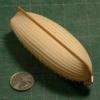-
Posts
13,303 -
Joined
-
Last visited
Content Type
Profiles
Forums
Gallery
Events
Everything posted by druxey
-
I don't think plank ends were ever left loose and hanging, Maury.
- 525 replies
-
- anchor hoy
- hoy
-
(and 1 more)
Tagged with:
-
Snap! I have an identical pair of pliers of about the same vintage. They are useful.
- 749 replies
-
- albertic
- ocean liner
-
(and 2 more)
Tagged with:
-
Oops! I missed spotting the nail in your photo, Ed. I have one version of the holder with three sizes of groove and gaps along the length to minimise that rocking issue.
- 3,618 replies
-
- young america
- clipper
-
(and 1 more)
Tagged with:
-
Very adroitly restored, Michael. Too bad you can't do that as quickly with your leg! Hopefully it's healing without infection. I was wondering if parallel pliers would have assisted in straightening the stair carriage.
- 749 replies
-
- albertic
- ocean liner
-
(and 2 more)
Tagged with:
-
Nice going, Ed. I have a small stop on my 45 degree planing jig so I can use both hands to control the tool. You may find this a convenient item to add.
- 3,618 replies
-
- young america
- clipper
-
(and 1 more)
Tagged with:
-
A standard Blomefield 6-pounder was 6' 0" long. Cutters generally carried either 3-pounders (4' 6") or 4-pounders (5' 6"). Information from Adrian Caruana, English Sea Ordnance: The Age of the System, page 299.
- 1,051 replies
-
- cheerful
- Syren Ship Model Company
-
(and 1 more)
Tagged with:
-
Are you going to trim the plank ends back that are hanging in air?
- 525 replies
-
- anchor hoy
- hoy
-
(and 1 more)
Tagged with:
-
I'm with Wefalck on this - take good care of your files, use a file card and replace every 20 years!
-
Short twelves, Chuck? I doubt whether a cutter would have a heavier long gun than a six-pounder. Most had three or four-pounders. Later ones had 12 or 18- pounder carronades instead.
- 1,051 replies
-
- cheerful
- Syren Ship Model Company
-
(and 1 more)
Tagged with:
-
A clean room? What a novel concept, Michael! Nice work with the jewelers' saw, by the way.
- 749 replies
-
- albertic
- ocean liner
-
(and 2 more)
Tagged with:
-
'Short' versions of long guns at the bow, perhaps? Even so, the carriage has little space for recoil on the port side.
- 1,051 replies
-
- cheerful
- Syren Ship Model Company
-
(and 1 more)
Tagged with:
-

A Lorch Micro-Mill that never was ...
druxey replied to wefalck's topic in Modeling tools and Workshop Equipment
Excellent! I like the oiler you've incorporated. -

De Eendracht by kay - 1:50 - a dutch flagship
druxey replied to kay's topic in - Build logs for subjects built 1501 - 1750
Great progress, Kay! -

Looking for the Airfix kit of HMS Endeavor
druxey replied to Bill Morrison's topic in Plastic model kits
eBay? -
Glad you found the anomaly and corrected it in time, Maury.
- 525 replies
-
- anchor hoy
- hoy
-
(and 1 more)
Tagged with:
-
That is one sweet spider band, Frank! Well done.
- 649 replies
-
- dunbrody
- famine ship
-
(and 2 more)
Tagged with:
-
Very neat work indeed, Amalio!
-
Operator error? In your case, surely not! Thanks for your analysis of device error with increasing angle, Ed.
- 3,618 replies
-
- young america
- clipper
-
(and 1 more)
Tagged with:
-
Nice looking stoves there, Glenn. With the two stacks temporarily in position she suddenly looks like a paddle steamboat!
-

De Eendracht by kay - 1:50 - a dutch flagship
druxey replied to kay's topic in - Build logs for subjects built 1501 - 1750
An excellent beginning, Kay! -
Nice new 'digs', Rusty. The refinished desk looks terrific. Now, get back to model-making!
- 310 replies
-
- cheerful
- Syren Ship Model Company
-
(and 1 more)
Tagged with:
About us
Modelshipworld - Advancing Ship Modeling through Research
SSL Secured
Your security is important for us so this Website is SSL-Secured
NRG Mailing Address
Nautical Research Guild
237 South Lincoln Street
Westmont IL, 60559-1917
Model Ship World ® and the MSW logo are Registered Trademarks, and belong to the Nautical Research Guild (United States Patent and Trademark Office: No. 6,929,264 & No. 6,929,274, registered Dec. 20, 2022)
Helpful Links
About the NRG
If you enjoy building ship models that are historically accurate as well as beautiful, then The Nautical Research Guild (NRG) is just right for you.
The Guild is a non-profit educational organization whose mission is to “Advance Ship Modeling Through Research”. We provide support to our members in their efforts to raise the quality of their model ships.
The Nautical Research Guild has published our world-renowned quarterly magazine, The Nautical Research Journal, since 1955. The pages of the Journal are full of articles by accomplished ship modelers who show you how they create those exquisite details on their models, and by maritime historians who show you the correct details to build. The Journal is available in both print and digital editions. Go to the NRG web site (www.thenrg.org) to download a complimentary digital copy of the Journal. The NRG also publishes plan sets, books and compilations of back issues of the Journal and the former Ships in Scale and Model Ship Builder magazines.


